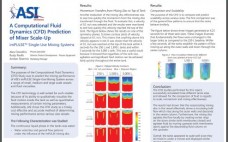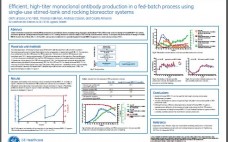Human mesenchymal stem cells (hMSC) are multipotent adult stem cells present in a variety of tissue niches in the human body. hMSC have advantages over other stem cell types due to the broad variety of their tissue sources, since they are immuno-privileged, and for their ability to specifically migrate to tumors and wounds in vivo. Due to these traits hMSC have become desirable tools in tissue engineering and cell therapy. In most clinical applications hMSC are expanded in vitro before…
Poster Hall
A Computational Fluid Dynamics (CFD) Prediction of Mixer Scale-Up: imPULSE™ Single-Use Mixing Systems
ASI-Life Sciences commissioned a CFD study of our imPULSE single-use mixing systems to predict and characterize the mixing performance of the systems across small, medium and large vessels and fluid viscosities. One characterization from the study as you will see in Figure 1 of the poster was the rate at which the momentum from the mixing disc transferred through the fluid. As you can see in the Figure within 5 seconds, fluid motion was achieved in the 250 L, 1,500…
Adopting a Fully Single-Use Process to Improve Speed to Clinic: A Leachables Case Study
The implementation of single-use technologies for pharmaceutical product development continues to gain momentum; this trend is due to the advantages of increased flexibility, speed of implementation and lower capital investment. In particular, they are seen as a means to accelerate the production of material for clinical trials. However, a primary concern regarding the use of such technologies is the impact and level of leachables in the final drug substance. Typically this concern is addressed through a risk assessment utilizing extractable…
Freeze-Pak™ STS Bio-Containers and STS Shippers: A New Single-Use Solution for Frozen Storage & Transport to -80°C
Frozen storage is commonly performed and enables manufacturing process flexibility, long-term product stability and minimizes logistics challenges. While single-use containers are available for storage and transport of frozen products, some require a significant investment while others don’t offer the necessary support and protection. Using films and bags not designed for frozen storage applications can be detrimental.  Charter Medical recently developed a new family of single-use frozen storage and transport solutions. The Freeze-Pak™ STS (FP-STS) bio-containers and supporting secondary single-use…
Optimization of HEK 293 and CHO-S Cell Growth by Supplementation of Non-Animal Derived Components Using Design of Experiments (DoE)
Mammalian cells are a widely used expression platform for the production of recombinant therapeutic proteins or viral particle-based vaccines since they typically perform appropriate protein post-translational modifications and authentic viral particle assembly. Of the available mammalian cells, CHO and HEK 293 are some of the most industrially relevant cell lines because they are cGMP compliant and are able to grow in suspension in a variety of serum-free media. Of note, production of human therapeutics in mammalian cell culture has become…
Purification of Clinical Grade MAb using Hydrophobic Cation Exchange Chromatography Resin
A three-step non-rProtein A capture process shows how the selectivity afforded by Nuvia cPrime resin can be used to clear a light chain contaminant that has a homologous sequence and similar pI to the target MAb monomer. The unique balance between the hydrophobic and charged character of Nuvia cPrime allows for a compact process with reduced buffer consumption and feed conditioning.
Optimization of the Rocking Speed and Angle of a Perfusion Bioreactor for T Cell Culture
For autologous T cell therapy to be effective, T cells sampled from a patient need to be grown in sufficient quantity before being injected back. The typical cell number required for an 80 kg patient is 8.109 cells. Achieving such a dose with T flasks, while maintaining cell health, poses logistical challenges that can become intractable when the number of patients rises. This is why the Xuri™ Cell expansion system W5, a rocking platform which enables automated high cell density…
Clinically Relevant T Cells Expanded Using the WAVE Bioreactor™ 2/10 System
Lymphocytes, expanded for clinical use, often consist of a small selected starting population, which requires multiple rounds of replication to achieve therapeutic doses. By using perfusion culture with the WAVE Bioreactor 2/10 System, high cell density cultures which are sufficient for therapeutic doses, can be generated. The Cellbag™ bioreactors, used together with the WAVE system, are functionally closed, single-use bioreactors that are delivered pre-sterilized and suitable for cGMP production. Perfusion is automatically maintained by the WAVE system, which removes metabolites…
Efficient High-Titer Monoclonal Antibody Production in a Fed-Batch Process Using Single-Use Stirred-Tank and Rocking Bioreactor Systems
This poster presents a study on the performance of two types of single-use in an antibody fed-batch process. The bioreactors were the stirred tank Xcellerex™ XDR-200 bioreactor and the rocking ReadyToProcess WAVE™ 25 bioreactor system. The cell line used was a CHO-DG44 derived antibody‑producing cell line and the base medium and feeds were from the ActiCHO™ media platform. The results from the parallel cultures presented in figures 3,4 and 5 show that cell growth, productivity and metabolism were very similar.…
In Silico and In Vitro Tools for the Rational Design and Optimization of Novel Vaccines
Subunit vaccines have been shown to have an excellent safety and stability profile compared to the more traditional inactivated or live attenuated vaccines. However, this increased safety is accompanied by the fact that subunit vaccines are often less immunogenic and require adjuvants to induce immunological memory. Comprehensive vaccine design and optimisation approaches can be used to identify the immunogenic parts of the pathogen that contain the B cell and T cell epitopes required for an immune response. Rationally designed vaccines…










